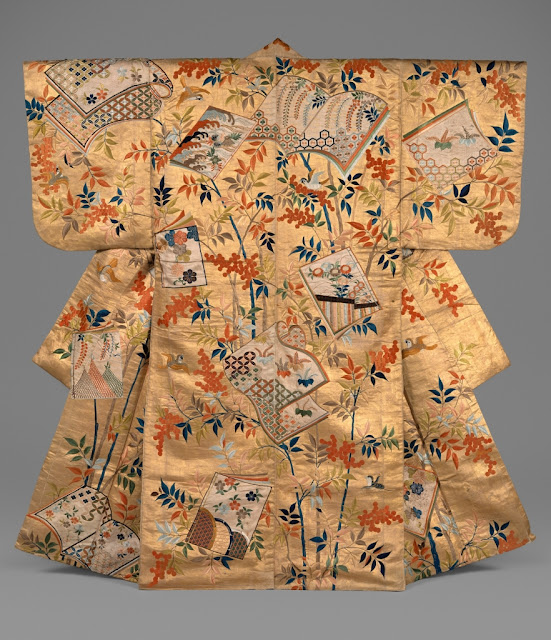photo source
Until 1980, when pieces of Japanese embroidery were exhibited at the national seminar of the Embroiderers' Guild of America in DalIas, Texas, its embroidery was hardly known outside Japan. One of the things that makes Japanese embroidery unique is the fact that it uses silk threads that come in up to 500 different colors. The pattern, the season and the age group of the person who will use the finished product all come into consideration when choosing the right colors.
Noh Costume (Nuihaku) with Books and Nandina Branches second half of the 18th century Silk embroidery and metallic leaf on silk satin The Metropolitan Museum of Art
Gift cover, 1850-1867. Velvet, embroidered with coloured silk and gold-wrapped thread The Victoria and Albert Museum
The embroiderer also chooses the appropriate techniques to be used. Japanese embroidery has 43 embroidering techniques, which vary in terms of thickness, bulge or dots. To select the style of embroidery suitable for a particular part of the pattern requires great skills. A satin stitch is used to create pattern elements such as flowers and leaves. These stitches use untwisted silk, which gives the embroidery a very rich sheen. Larger areas are defined with long and short stitches. Twisted threads are used to give a nubble appearance. Another type of texture is created with a knot stitch. Gold or silver thread is also used in Japanese embroidery. This is made from a silk core wrapped in paper and then with gold or silver leaf. The resulting thread is too thick to pass through fine silk without damaging it, so is couched on to the fabric.
Gift cover late 19- early 20th century Silk; metal thread; Embroidered; couched; satin stitch; chain stitch The Textile Museum of Canada
Embroidery illustrating of Sakyamuni Preaching, 8th century, embroidered silk. White plain-weave silk forms the expansive ground of this embroidery. French knots are used for Sakyamuni's curls and pedestal, the jewelry and clothing of the bodhisattvas, and parts of the objects held by the Ten Disciples. The rest of the embroidery is executed in chain stitch with z-twist yarns, and the spaces between the sacred and human figures and other such areas are similarly filled with lozenge-shaped patterns of chain stitch. Three-dimensionality is achieved by the varying sizes of the French knots, the thickness of the chain stitch, and the way in which the stitches change direction according to subject. The work displays the artist's deep understanding of and proficiency in embroidery techniques. The Nara National Museum
The embroidery patterns are largely inspired by nature: flowers, birds, plants, water or wind, but in a stylized, yet naturalistic way.
Wedding kimono, early to mid 20th century. Silk; metal thread; silk floss. Embroidered; couched; satin stitch The Textile Museum of Canada
The art of embroidery in Japan has a long history. The oldest survived embroidered piece - Heavenly Paradise Mandala - dates back to the seventh century. At that time most of the embroideries were used to decorate Buddhist banners for mourning ceremonies and rituals. Those banners were sewn and embroidered by friends and relatives of the deceased. Beside that, creative stitching decorated ceremonial robes for the emperor and the nobility. During the Muromachi period (1333-1568) embroidery started to be used as a substitute for expensive brocades. Embellishment of kosode robes and Noh costumes combined embroidery with imprinted gold or silver leaf. During the Momoyama period (1568-1600) stitchery was used to embellish soft silks of that time. Untwisted silk and gold or silver thread was used to create small simple designs. By the end of the era embroidery had reached its height. Fabulous Noh costumes and kimono entirely covered with embroidered designs were created at that time.
Wall hanging, late 19th century. Silk; metal thread. Embroidered; couched; satin stitch The Textile Museum of Canada
Outer Robe (Uchikake) with Mandarin Oranges and Folded-Paper Butterflies, late 18th–early 19th century. Tie-dyed satin damask with silk embroidery and couched gold thread. The Metropolitan Museum of Art
Hanging, late 19th century. Embroidered plain weave cotton with silk and metallic threads The entire surface of the cloth has been embroidered, in a wide range of stitches. The Victoria and Albert Museum
During Edo period embroidered motifs became more Japanese in style and the popularity of this decoration increased but soon, however, declined because the simpler and less expensive method of applique emerged.
Over so many centuries, traditional Japanese embroidery has become a style in its own right and now shines as a paramount achievement in the world of textile art.
References
Textile Art of Japan by Sunny Yang and Rochelle M.Narasin
Japanese embroidery by Arjen de Winter











What a fascinating post! I absolutely loved reading about Japanese embroidery. The only thing I knew about it (prior to reading this post) is that it was quite developed in the past. I had a memory of seeing embroidered traditional clothing that were beautiful to behold, but that was all. I didn't know there were so many different techniques and so many colours of the silver thread (500!) they used. I remember your other posts about other Asian embroidery styles and those were very interesting to read too.
ReplyDeleteThat piece from Nara museum totally blew me away! I can't believe that it is not a painting, the colours are simply...in want of a better word...simply magical!!!!
I think these embroidery is your latest collection. Nobody does not know before it.
ReplyDeleteFurther, you Click here https://samedaygaragedoorservicesga.com/ for Garage Door Companies service at lowest cost.
Fabulous post Online Digitizing
ReplyDeleteLook this one:
ReplyDeletehttps://thecrossstitchpatternboutique.myshopify.com/products/spring-elegance-of-japan-cross-stitch-pattern-pdf-geisha-kimono-embroidery-design-japanese-cherry-blossom-scene-instant-digital-download?variant=56123439546741